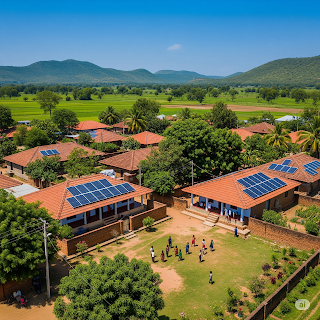What is PM Surya Ghar Yojana?
Launched in early 2024, the PM Surya Ghar Muft Bijli Yojana is a central government scheme aimed at making solar energy accessible and affordable for Indian households. Under the initiative:
Households receive up to 300 units of free electricity every month.
Subsidies are offered to install rooftop solar panels.
The application process is streamlined via a dedicated government portal.
With an allocation of over ₹1.25 lakh crore, the scheme targets the installation of rooftop solar systems in 1 crore households by 2027.
📈 Why It Matters
India is one of the world’s fastest-growing energy consumers. With over 300 sunny days annually, the country has enormous potential for solar energy generation. However, until recently, rooftop adoption remained low due to:
High upfront costs
Complex installation procedures
Lack of awareness or trust in solar products
PM Surya Ghar addresses these challenges directly, democratizing access to clean energy.
🔋 Key Features of the Scheme
Financial Subsidies:
Up to ₹75,000 subsidy for 1kW systems
Higher subsidies for larger systems (up to 3kW and beyond)
Direct Benefit Transfer (DBT):
Subsidy credited directly to the beneficiary's account, reducing dependence on intermediaries
Easy Online Registration:
Via the official portal pmsuryaghar.gov.in
Grid Connectivity:
Any extra electricity generated can be sold back to the grid, turning homes into net power producers
🌍 The Broader Impact: Climate, Economy, Empowerment
🌡️ Environmental Benefits
Cuts carbon emissions significantly
Decreases urban heat footprint from cement rooftops
💰 Economic Impact
Households can save between ₹1,200 to ₹2,500 monthly
Boosts domestic manufacturing under the Make in India initiative
Creates new jobs in solar tech, maintenance, and installation
🧳 Women and Energy Access
In rural areas, improved energy access supports:
Cleaner cooking alternatives
Education and digital inclusion
📊 Where Does India Stand in 2025?
According to MNRE data:
India has reached over 15 GW of installed rooftop solar capacity in 2025
PM Surya Ghar alone accounts for over 4.5 GW, across 60 lakh homes
Maharashtra, Gujarat, Tamil Nadu, and Rajasthan lead the adoption race
🚀 Challenges Ahead
Despite its success, the scheme faces certain hurdles:
Low awareness in remote rural areas
Limited financing options for some households
Solutions may include:
Tie-ups with banks for zero-interest EMIs
Real-time grievance redressal via the portal
📊 Future Outlook: India’s Path to Net Zero
India aims to achieve 500 GW of non-fossil fuel capacity by 2030, and rooftop solar is expected to contribute at least 100 GW.
PM Surya Ghar, alongside other policies like the Green Hydrogen Mission and Battery Storage Roadmap, is critical to:
Lowering emissions
Reducing energy imports
Making India a clean-tech manufacturing hub
📖 Conclusion: A Homegrown Solar Revolution
PM Surya Ghar isn’t just a subsidy scheme—it’s a citizen-driven climate movement. From rural huts to urban high-rises, it enables every Indian to become a part of the clean energy transition.
With stronger outreach, better financing, and inter-agency coordination, this rooftop revolution can light up millions of homes—and futures.

No comments:
Post a Comment